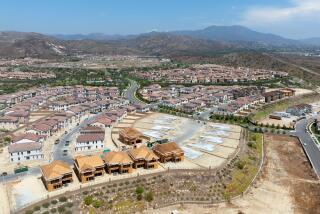CLIPBOARD
There are no signs or plaques marking historical sites in Villa Park, but local historian Louise Booth knows the facts behind the old buildings and even some of the new ones.
Booth, a retired Anaheim High School English teacher, is the author of “Villa Park: Then and Now.” The 80-page book, published in 1976, is full of local lore and information gathered mostly from descendants of founding families.
“It’s a good thing I interviewed them when I did,” Booth said. “Most of them have passed away and all of that information would have been lost.”
Booth has lived in the southern portion of Villa Park with her husband, Donald, for nearly 22 years. She can tell you when the Santiago Boulevard Bridge was wiped out by a flood, where the original Villa Park Orchard Assn. packinghouse stood, and where aircraft designer Claude Ryan lived when he was a boy.
When discussing the history of the neighborhood recently, her starting point was the home of the late Willard Smith, who served on the Orange County Board of Supervisors for 30 years.
“His parents were pioneers here,” she said. Their farmhouse, built about 1885, is still on Santiago Boulevard but tall trees and overgrowth obscure any view of it from the street.
The community’s first school was located on the Smith ranch until a schoolhouse was built at the corner of Lincoln Street and Center Drive in 1883. Although the original structure was torn down about 1919, newer buildings were constructed and Villa Park Elementary school is still here. The pepper trees in the schoolyard were planted in 1883 by Villa Park pioneer F.D. Collins, who kept them alive with water hauled up from his ranch.
“The community has always been active in the school, and that hasn’t changed at all,” said Joe Fortier, principal of Villa Park Elementary. Parents of the school’s 540 students formed the Home and School League, and raised funds to hire Lini King, who coordinates the school’s science program.
“We’re really lucky to have her, and providing funds for additional staff is a very unique thing for a parents’ group to do,” Fortier said.
The homes in the surrounding neighborhood are among the most expensive in Orange County, which helps explain why the population decreased 6.2% between 1980 and 1990.
“It’s difficult for young families to buy a home here now, although some still manage to do so,” Booth said. “But in the past few years a lot of the investment in this neighborhood has come from foreign money.”
Booth said that during the late 1970s and early 1980s several Iranian families purchased homes in the area. “Now we’re seeing people move here to get out of Hong Kong, before Red China takes it over,” she said.
Over the years, residents have fought off several attempts to allow mobile home parks and multifamily dwellings. They succeeded in stopping the construction of townhouses at the former site of the Villa Park Orchard Assn. A development of detached single-family homes is now under construction there.
The neighborhood will never return to the farmland it was when Booth arrived. But, with its large lots and its lack of sidewalks and street lights, it retains at least some of the flavor of its rural past.
Population Total: (1990 est.) 3,509 1980-90 change: -6.2% Median age: 32.9 Racial/ethnic mix: White: (non-Latino) 84% Latino: 5% Other: 11% Blacks: less than 1% Income Per capita: $23,234 Median household: $72,212 Average household: $82,020 Income distribution: Less than $25,000: 10% 25,000-49,999: 15% $50,000-74,999: 28% $75,000-99,999: 19% $100,000 and more: 28% Males Median age: 31.0 years Females Median age: 36.1 years
More to Read
Sign up for Essential California
The most important California stories and recommendations in your inbox every morning.
You may occasionally receive promotional content from the Los Angeles Times.










